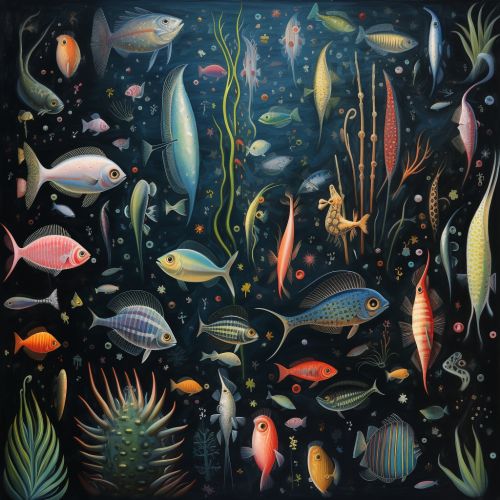Ichthyoplankton
Overview
Ichthyoplankton are the eggs and larvae of fish. They are usually found in the sunlit zone of the water column, less than 200 meters deep, sometimes called the epipelagic or photic zone. Ichthyoplankton are planktonic, meaning they cannot swim effectively under their own power, but must drift with the ocean currents. Fish eggs cannot swim at all, and are unambiguously planktonic. Early stage larvae swim poorly, but later stage larvae swim better and cease to be planktonic as they grow into juveniles. Fish larvae are part of the zooplankton that eat smaller plankton, while fish eggs carry their own food supply. Both eggs and larvae are themselves eaten by larger animals. Read more about fish reproduction.


Classification
Based on the size and the developmental stage, ichthyoplankton can be classified into two main groups: fish eggs and fish larvae. Fish eggs, also known as roe, are generally spherical or ellipsoid in shape, and they are usually laid in large numbers. Fish larvae, on the other hand, are the early developmental stages of fish, which undergo several changes before they become juveniles.
Fish Eggs
Fish eggs are the reproductive cells or gametes of fish. They are typically spherical or ellipsoid in shape and are laid in large numbers. The size of the eggs varies depending on the species. Some species lay eggs that are only a few millimeters in diameter, while others lay eggs that are several centimeters in diameter. The color of the eggs also varies, ranging from transparent or translucent to bright colors such as red, orange, yellow, and green. Read more about fish eggs.
Fish Larvae
Fish larvae are the early developmental stages of fish. They are typically small, transparent, and have a simple body structure. The body of a fish larva consists of a head, a trunk, and a tail. The head contains the brain, eyes, and mouth. The trunk contains the heart, digestive system, and other internal organs. The tail is used for swimming. As the larva grows, it undergoes several changes, including the development of fins, scales, and other features characteristic of adult fish. Read more about fish larvae.
Distribution and Habitat
Ichthyoplankton are found in various aquatic environments, including oceans, seas, lakes, and rivers. They are most commonly found in the sunlit zone of the water column, which is less than 200 meters deep. This zone is also known as the epipelagic or photic zone. In this zone, the water is warm and there is plenty of light for photosynthesis. Ichthyoplankton are also found in the mesopelagic zone, which is between 200 and 1000 meters deep, but they are less common in this zone. Read more about aquatic ecosystems.
Ecology
Ichthyoplankton play a crucial role in the aquatic food chain. They serve as a food source for a variety of organisms, including other plankton, fish, birds, and marine mammals. Fish eggs carry their own food supply, which provides them with the necessary nutrients for growth and development. Fish larvae, on the other hand, are part of the zooplankton that eat smaller plankton. As they grow into juveniles, they begin to eat larger prey. Read more about the aquatic food chain.
Research and Monitoring
Research and monitoring of ichthyoplankton are important for understanding the dynamics of fish populations and for managing fisheries. Scientists use various methods to collect and study ichthyoplankton, including net sampling, light trapping, and acoustic surveys. These methods allow scientists to estimate the abundance and distribution of ichthyoplankton, to identify the species, and to study their growth and development. Read more about fisheries science.
